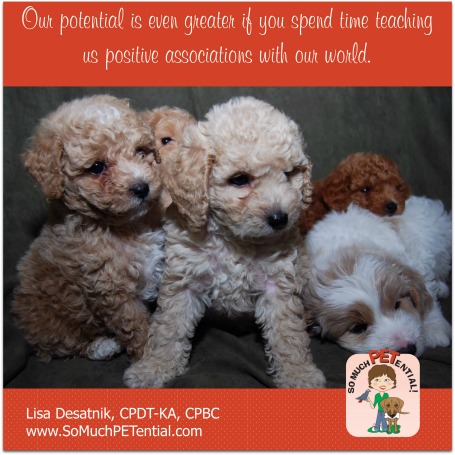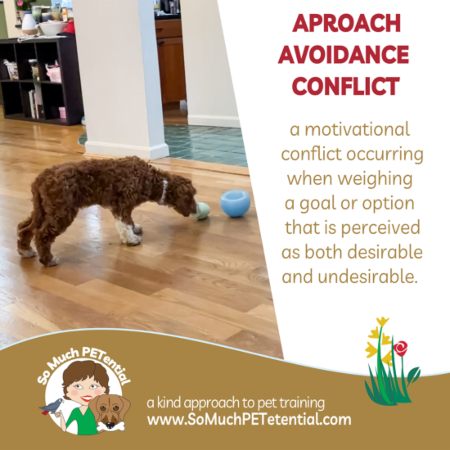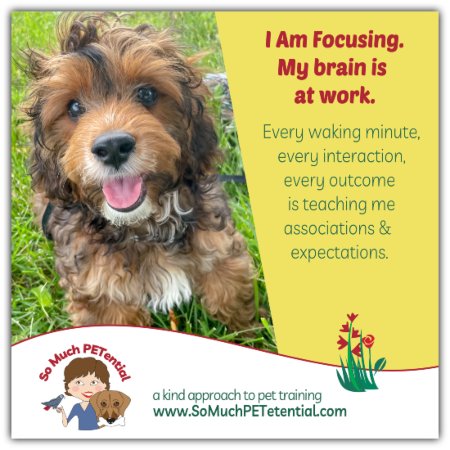When it comes to setting your young puppy up for success to handling life experiences with confidence and an eagerness to discover and learn rather than approach unfamiliar noises and sights with trepidation, the greatest gift you can give your new companion is early socialization.
 The sensitive period for this is at approximately four to twelve weeks of age (with the time frame of eight to ten weeks known as the ‘fear period’ where negative experiences can last a lifetime). It is during this period when experiences can have long lasting impact on your dog’s behavior.
The sensitive period for this is at approximately four to twelve weeks of age (with the time frame of eight to ten weeks known as the ‘fear period’ where negative experiences can last a lifetime). It is during this period when experiences can have long lasting impact on your dog’s behavior.
What exactly do I mean by ‘socialization’?
Good socialization is so much more than simply exposing your puppy to new stimulus. It is about being diligent to ensure that interactions with his environment are fun, positive, and definitely not overwhelming. Any time a puppy is not enjoying the situation; there is the potential for doing more harm than good. However, short exposure to unusual objects, surfaces, sights and sounds where your puppy feels good (and you will know by his body language) are very empowering and resilience building.
Here are some suggestions to keep in mind when it comes to positive socialization:
Keep experiences short, at a time when you can be actively focused on your puppy and his emotional state. Bringing your puppy to your child’s softball game or to a busy public event has the potential for doing harm if you are distracted, allow people to crowd around or handle a puppy that is uncomfortable, a loud noise or in-your-face dog or child scares your puppy, or any number of other situations occur to cause your puppy to have a negative experience. Going to an event and being at a distance where your puppy shows loose body muscles, can focus on you and the environment, and can accept food is a better idea; allowing your puppy to move forward at his own pace – always with the option to move away.
Similar thoughts – Do not let well intentioned strangers overwhelm your puppy by surrounding him, lurking over him, grabbing him, tugging, hugging or lurching over him. Do not ever force your puppy to approach or interact with anyone or anything that they are backing away from or showing any hesitancy around (tense muscles, turning away, yawning, muzzle licking, etc.). These puppies need help building their confidence. Instead, move away and give your puppy distance and begin teaching positive associations by pairing the stimulus with something positive while allowing your dog to approach at his own pace.
Lots of short socialization sessions are better than longer ones. There are some puppies who should not go out every day. If you are out for a longer outing, you can give your dog a break by allowing it to relax in a safe and secure crate in the car (that is, if your puppy is relaxed in the crate and car).
Be careful of using food to lure. Luring a puppy into an uncomfortable situation, to decrease distance between it and something or someone new, can have negative consequences. That food may draw him closer but as soon as the food is gone, those puppies find themselves where they do not want to be and suddenly may exhibit a fear response. Food should be used to reinforce behavior (given to a puppy AFTER a behavior) not to lure a puppy, especially when it comes to socialization.
A dog park is not the place to teach socialization. Please see my post on dog parks. Also, it is safest to not allow your puppy to meet another unknown dog while both are on leash. Relying on a complete stranger to be honest and objective about his/her dog’s behavior is gambling with your puppy’s safety. Especially be aware of both dogs’ body language.
Have goals in mind with your puppy’s experiences. Are you going someplace to simply observe or to interact? Will you be taking your puppy to a new place to meet new people or to simply observe or play? Do you want your puppy to habituate to bikes or other moving vehicles so that they are just background? Always know when to stop (before your puppy becomes overly excited or shows a fear response). Stop the experience at its peak.
Give your puppy positive experiences with a wide variety of surfaces, sights, sounds, animals, environments, and people. You can give your puppy exposure also to other dogs and stimulus by sitting in a parking lot and letting your puppy watch, pairing the sights and sounds of the environment with valued reinforcers.
Teach your puppy that you are fun to pay attention to even in the presence of other stimuli in other environments.
Teach your puppy that alone time is okay too. Puppies who are taught tolerance of being alone will be more adjusted.
Teach your puppy that calm behaviors or behaviors you want to see more of, are the behaviors that get him what he wants in life. Do not teach your puppy that uncontrolled wild and craziness gets him good stuff in life. Please see my post on impulse control in dogs and puppies.
Can I be of further help for you and your dog? Please contact me here.






